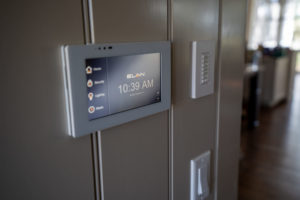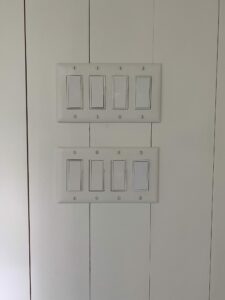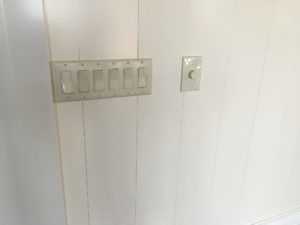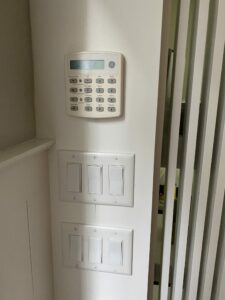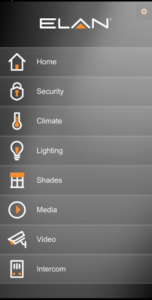I love that this post presents a two sided question right from the start. It gives us a chance to ask ourselves a fundamental question. Are you a “Smart” home Contractor or are you a “Smart Home” contractor? The simple answer is you cannot be one without the other and understanding what makes a home truly smart is the key. If you do a quick internet search for the definition of Smart Home you’ll find answers like these..
Although there is some very basic truth to these answers, the reality is that both miss the real target.
The reason most of our clients want AIC to design a smart home is to lesson the amount of thought, time, and energy they use just managing their day to day lives. They simply “don’t want to have to think about stuff”. Giving my clients a mobile device crammed full of different apps to control their thermostats, lighting system, alarm system, video cameras, etc isn’t making their lives any easier, it’s just creating a different type of chaos. It still leaves the task of having to physically do something in the clients hands. A task that is more than likely repeated each and every day. It’s simply trading one way to control things for another.
A smart home should be truly automated and designed in a way that the devices within the system, like Lighting, Security, Automated shades, A/V, Pool/Spa, Irrigation can work together to create a home that mostly runs itself based on your clients specific needs, requests, and most importantly their expectations and lifestyle. Not a phone full of apps. That’s no different than a handful of remote controls.
Here’s what I mean by this…
Let’s say that you have a home that has multiple Lighting Loads within the main living areas of the home like the kitchen, breakfast room, great room, and rear porch. These would typically include recessed cans, island pendants, undercounter lights, tape lighting, and other types of lighting fixtures. The typical way to control these would be to clutter the walls with huge banks of switches, dimmers, and fan controls that are ugly and confusing. How many of your clients have pieces of blue painters tape stuck to their light switches to remind them what light it controls? Come on, Be honest.
Let’s keep following this line of thought. Now, let’s say instead of installing traditional lighting switches , you install smart switches that can be controlled by a mobile device. Unless this system is going to understand and learn your clients daily routines and preferences, all you are doing is trading a bank of light switches for a mobile device full of confusing apps. You could see why the painters tape would make more sense to some clients and builders alike.
A simpler, more realistic, and relatively cost effective solution to this type of design would be to use a Lutron 6 Button Lighting Keypad in lue of the multiple switches and dimmers. As humans we eventually start to repeat the same series of lighting scenes and learn the painters tape, but how much better as a contractor to offer a solution that eliminates the wall clutter and at the same time gives the client a much friendlier way to control their lights. An easy to use Elan touchscreen offers a sleek all in one solution for controlling other systems like the security, HVAC, Pool/Spa, irrigation, video cameras, automated shades , audio / video, home theater, and intercom.
The photo below shows an 8″ Elan touchscreen positioned next to a Lutron (6) button keypad. A seamless solution without the need for redundant wall controls like thermostats, security keypads, pool and spa controls, and light switches or dimmers.
The photos below show a variety of cluttered walls with very little forethought and/or home control.
So now that we’ve added a simple lighting system to the project we should ask ourselves what other types of automation and integration we can incorporate. Since thermostats are found in 99% of homes and security systems are found in 38% of home’s throughout the U.S. these are the most requested automated and integrated systems within a home. This is where I believe most of the confusion comes into play when it comes to understanding and choosing the right “Smart Home System” and where typically “Do it yourself” or (DYI) projects fall short.
A typical (DYI) design is based on using systems similar to Philips Hue Lighting, Nest Thermostats, Google Cameras, and an ADT Security System. The problem with these types of systems is that they simply do not play nice together. All of these manufactures want to offer an “All in One ” solution but continually fall short in doing so and the end result is a lot of confused end users with multiple apps that continually need some type of update and never seem to work. A well planned system would work together to create a true “Smart System”.
A much smarter and more user friendly automation system would take advantage of all of the information available within each smart device and create an integrated family of devices that work together to make proactive and practical everyday decisions.
Security and Alarm systems are a perfect example. They simply sit and watch us walk back and forth all day long and beep when a door opens. Unless there’s an actual burglar or fire event the devices associated with the alarm system are useless 99.9% of the time and have no benefit to us. Unless we utilize them for other purposes.
An example of this would include programming the lighting system to turn on the master suite hall lights to 10% brightness if the motion detector sees motion between the hours of 8 PM and 6 AM for simple nighttime pathway lighting. Another option could include having the outdoor lighting blink rapidly if there’s a security alarm in progress to alert the neighbors that help is needed. These are a few simple examples of how automation should work together and leave as much thinking as possible out of the clients hands.
So now that you hopefully understand that a “smart home” is not handing a client a phone full of Apps, but a system that can automate and integrate the daily routines of our clients lives. Let’s get to the basics of how to become a smart home contractor.
First and foremost, learn the basics of home technology. Stop depending on the proverbial line of shit that the local A/V guy or box store geek is probably feeding you. They continually make you look bad. Most contractors can talk your ear off when it comes to laying a foundation or building a roof and they know when a sub-contractor lacks experience pretty quickly. So why is it when it comes to technology so many incredible contractors and home builders are completely lost? The answer is simple. The consumer electronics industry is enormous with all of the different options and changes in technology seem to happen overnight. There’s simply no way for a general contractor to be able to keep up with all of the changes and options and still get homes completed.
So the first thing you should do to become a smart home contractor is to:
1.) Partner with a reputable Home Technology Company:
One that has a solid background and good standing in the area where you are building. Make sure the company can offer all aspects of a Smart Home, from A/V, to Lighting control, to automated shades. Most of these companies will have tried and true systems that they are familiar with. Systems that are extremely reliable. The last thing you want is a bunch of sub-contractors blaming one another for every problem. Someone has to be the quarterback. Advanced Integrated Controls has chosen to partner with companies such as, Elan Control Systems and Lutron to offer endless custom solutions for our clients.
Your Home Technology Specialist should also have a showroom or experience center which will allow your clients to experience for themselves what types of systems they may want to incorporate into their new home. A physical showroom location also gives the client a sense of security. Somewhere to sit down and go over a set of drawings and design a plan that’s catered to the client’s specific goals and expectations.
I’m thankful that the builders I work with day to day allow me to sit down with clients early in the building process. It gives me a chance to understand a clients needs and expectations early on and pass any pertinent information on to the builder. “How many times has a client forgotten to tell you about the motorized shades they wanted just before drywall is going up?”
2.) Understand the importance of solid networks:
To understand the basic workings of a Smart Home you have to start at the foundation. Just as the slab is the foundation for building a home, the network is the very backbone for a Smart Home. Thinking that expensive network systems provide nothing more than “bells, whistles, and a higher price tag” is a common misconception. Managed static IP assignment, multi V Lan, enhanced security features, fluid WIFI calling and Seamless Roaming WIFI are just a few options that come with a solid network system.
A common misconception is that a Home Technology system based on using completely wireless devices is acceptable. You ever notice that almost every wireless device from Apple TV streaming players to Sony Smart TVs have a hard wired ethernet connection available? Ever wonder why? It’s simple, a hardwired network connection is always faster and more reliable than a wireless one.
In today’s world we are doing everything we can to reduce the amount of wireless traffic on a network. Hardwiring and assigning static IPs to every technology component possible. This would include Smart TVs, streaming players, video cameras , the lighting system, and more. Hardwiring these components assures that the system will restore itself after power outages, but it also eliminates congestion on the WIFI system that is so critical in today’s world of Home Schooling and Video Conference Calling.
3.) Wire by design and with foresite:
As I mentioned in the paragraphs before, hard wiring as many electronic devices to the network is key to a solid and successful smart home system. We should also understand by now that going wireless is NOT the best way, even though it can sometimes seem like the easiest way. The pre-wiring of the home is by far the least expensive and most critical phase of the entire project.
That being said, AIC typically runs a Structured Cable that is comprised of (3) dedicated Cat6 lines and (1) RG 6 Quad shielded coax cable to each TV location throughout the home. The Coax is for those clients stuck on using traditional cable or Satellite TV services. The coax can also be used as a 2 conductor communication line with the use of a simple converter at any time giving flexible options to add soundbars and other speakers and/or subwoofers at any time.
Although at first glance this amount of wiring may seem like overkill, now that you understand the principles of hardwiring electronic devices for speed and reliability this makes total sense. Most TV solutions today include a Smart TV, a streaming device like Apple TV or Roku, and possibly a cable set-top box and/or directv Receiver. Assuming this is the case, the TV and streaming player would each use one of the Cat6 cables, a cable box would tie up the coax, and we have a spare to add a potential WIFI hotspot for those dead areas.
WIFI Access points should be pre-wired based on using today’s high speed 5Ghz transmission protocol. It’s real easy to drop a couple of 2.4 Ghz access points around the house and say there’s complete coverage, but 2.4 Ghz cannot produce speeds over 90 Mbps. 5 Ghz WIFI systems can produce download speeds up to 1000 Gbps or 1 Gig. 2.4 Ghz WIFI access points offer twice the coverage and while costing 75% less, but you get what you pay for. If you’ve ever tried streaming a movie using a 2.4 Ghz WIFI system you know exactly what I’m talking about. Constant buffering. TV resolutions change from standard resolution to HD quality back and forth, etc…
Basically what i’m saying is that the wiring design of the house should cover all of the home owners expectations while still offering flexibility to add and/or change the design at any time. Basically having your clients back.
An example of this would be a situation where a client is not sure whether or not they want any type of surround sound in let’s say the Family Room. They know they want to wall mount a TV above the fireplace and potentially have a couple of speakers, but surround sound may be overkill. Overkill until the walls are up and the house is completed and they realise the sound coming just from their TV paired with the 14 foot vaulted ceilings sucks.
In this situation I would recommend wiring for the TV and (2) In-Ceiling type speakers. Add an optional speaker line with the TV wiring for a possible future soundbar. A soundbar that can then be paired with the (2) In-Ceiling speakers for a more immersive TV sound experience at any time. That is wiring with foresite and experience.
Curt Hubner / Advanced Integrated Controls



